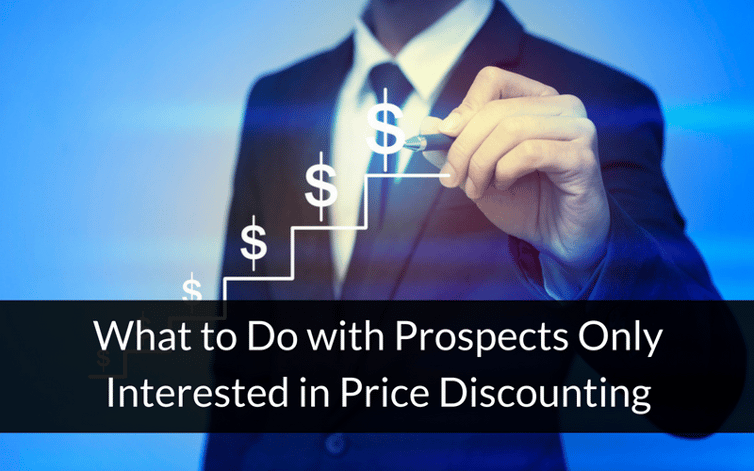
Discounting the price of your product or service may seem like a fast and easy way to close a deal, but in the long run, you will literally be selling your company short.
It’s easy enough to see how price discounting can get started:
- It’s the end of the quarter and the sales team needs to meet their goals.
- The economy within the industry is trending downward, and sales have been sluggish for too long.
- There is a component of your sales rep’s compensation that inadvertently rewards discounting.
- Your competitor is offering discounts, and you think you need to match prices to keep your customers.
So how can you change your sales culture so discounting isn’t rewarded and your prospects value your products and services not for their price tag, but for what they can do for their business?
Let’s first take a look at what happens when you discount and how it negatively affects the value of your offering.
What Happens When You Discount?
Here are the dangerous outcomes of consistently discounting your solution.
1. You Get a Temporary Increase in Revenue at the Expense of Profits
Maybe your sales leaders are evaluated on their ability to post revenue gains quarterly. To increase the quarterly revenue gains, the sales reps need to sell products quickly, so they offer discounts.
However, because of the discounted price, they now must sell more products to meet the revenue goals. And even worse, every dollar of your price discount takes a dollar of profit off the bottom line. A 5% discount on all deals could equate to a 50 percent reduction in profitability. Now the reps are in an endless loop of selling and go after unqualified leads instead of looking for higher value prospects.
When profits drop, there is no money for research and development or marketing. Your company starts to sink due to a lack of improved or new products and a lack of customer awareness.
2. You Commoditize Your Offering
If you discount, you have made your formerly unique offering a commodity that can be bought anywhere as long as the price is right. There is no discussion of value whatsoever. The prospect is settling for a solution that doesn’t fully solve a problem.
Commoditization forces you to develop and build products more quickly and cheaply. You may not be able to retain quality, and shoddy workmanship starts to damage your brand. Your prospects will pay a premium to go to a competitor who can solve their problems with a quality offering.
Those prospects who are left now have a transactional mindset that makes them seek short-term gain. They will not stay loyal to you; as soon as they see a lower price, they are gone. There are no opportunities to upsell or cross-sell to increase revenue.
How to Turn it Around
So what can you do to avoid price discounting and sell on value?
1. Align Your Compensation and Incentives with Strategic Goals
If your current compensation program rewards your sales reps for volume, the urge to discount becomes quite strong. Plans of this type are often found in companies where there is a culture of discounting; the leaders need to steer the company in a more balanced direction.
To learn if your company is inadvertently providing incentives for the wrong behavior, perform an audit of all your compensation and incentive programs to determine what is rewarded. If the rewards lead to discounting, change the program to one more aligned with the company's strategic goals. Compensation and incentives should encourage looking at the long-term health of the business, not short term revenues.
2. Train Your Sales Reps about Value
If you see your sales team is uncomfortable talking about anything besides features and benefits, put together a training program that teaches them how to sell on value.
Teach them how to systematically and strategically move the conversation away from price and how to determine measurable financial benefits that prospects care about. Train them in having discussions about what a prospect is willing to pay for benefits that are tailored to a company-specific problem.
Show the sales team how to make use of the value selling tools you have available, such as a TCO tool or ROI tool, that provide numbers a financial team will pay attention to.
3. Invest in an ROI Tool
If you don’t already have these tools, invest in them. The ROI tool is your go-to tool to show value and defend your price. In the hands of a trained sales rep, the ROI tool becomes a tool for building winning business cases. It provides the type of information your prospect needs to get buy-in from internal committee members and/or the CFO.
A discussion showing return on investment and payback period is significantly more compelling than a conversation about prices and discounts.
Conclusion
Don’t fall for the price discounting trap. Instead of getting a temporary increase in revenue at the expense of profits or commoditizing your offering, focus on training your reps about value, aligning compensation and incentives with strategic goals, and investing in an ROI tool.
These tactics will help you keep the prospect focused on the value of investing in your solution rather than how many dollars they can knock off the purchase price.









